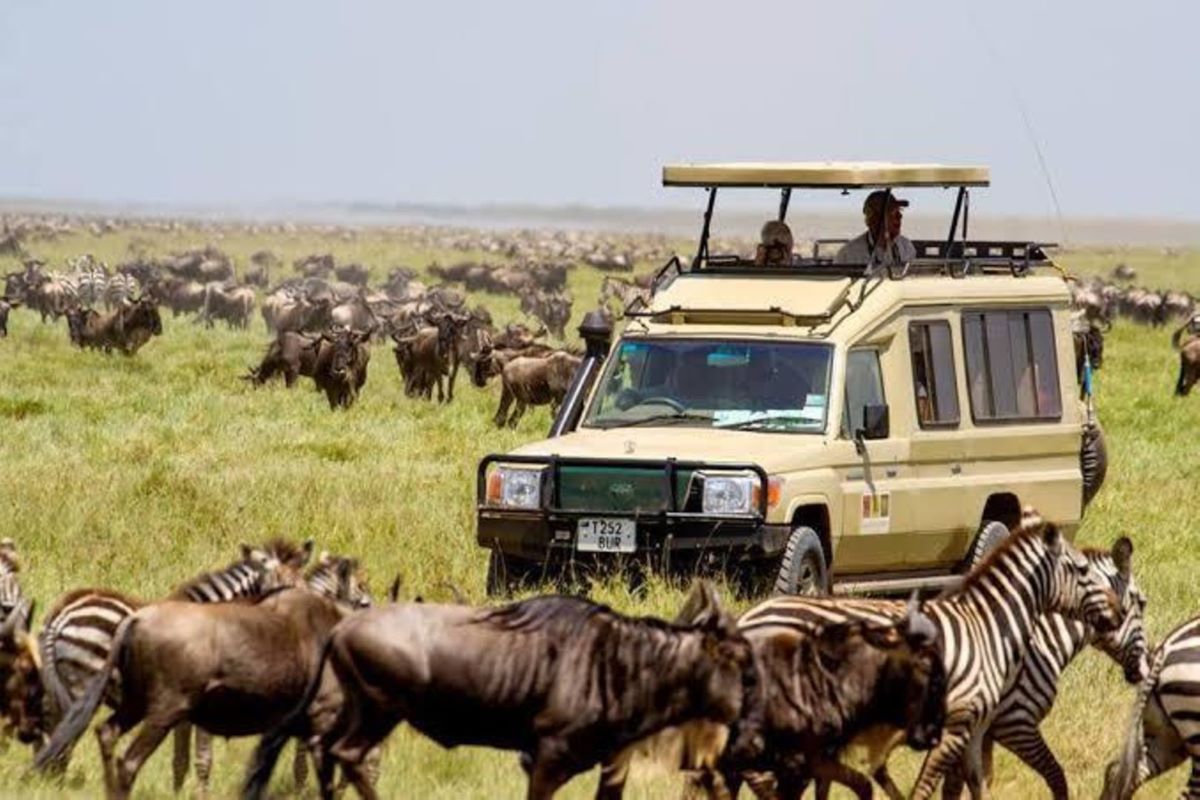
Tanzania’s tourism sector expanded significantly in 2024, with 1,748,500 tourist arrivals (+12.4%), generating USD 3,259.8 million in earnings (+9.5%). The sector contributed 17.2% to GDP, up from 16.4% in 2023, and supported over 1.5 million jobs. Serengeti National Park remained the top attraction, receiving 589,300 visitors (+11.2%), while Mount Kilimanjaro saw the fastest growth (+13.4%). However, rising costs and regional competition pose challenges, requiring continued investment in infrastructure and marketing to sustain growth.
1. Tourism Sector Growth: Strong Recovery and Increased Earnings
What It Means:
✅ More tourists are visiting Tanzania, showing post-pandemic recovery and increased global interest in Tanzanian destinations.
✅ Higher earnings indicate stronger foreign exchange inflows, supporting the economy.
⚠ The growth rate has slowed slightly compared to previous years, requiring further tourism development strategies.
2. Visitor Arrivals by Region
What It Means:
✅ Europe remains Tanzania’s largest tourism market, but North America and Asia are emerging as key growth areas.
✅ Regional tourism from African countries is growing, supporting cross-border trade and investment.
⚠ More investment is needed in marketing to diversify Tanzania’s tourism sources further.
3. Key Tourism Destinations and Their Growth
| Tourism Destination | Number of Visitors (2024) | Growth from 2023 (%) |
| Serengeti National Park | 589,300 | +11.2% |
| Zanzibar Beaches | 478,900 | +9.6% |
| Mount Kilimanjaro | 295,400 | +13.4% |
| Ngorongoro Crater | 273,600 | +10.1% |
What It Means:
✅ Serengeti remains the top attraction, but Zanzibar and Kilimanjaro are gaining more visitors.
✅ Growth in mountain tourism (+13.4%) shows increased interest in adventure tourism.
⚠ More investments in infrastructure and conservation are needed to sustain growth.
4. Contribution of Tourism to Tanzania’s Economy
What It Means:
✅ Tourism is a key economic driver, supporting jobs and GDP growth.
✅ Higher hotel occupancy rates indicate strong demand, benefiting the hospitality sector.
⚠ More investment is needed in training and service quality to maintain competitiveness.
5. Challenges Facing Tanzania’s Tourism Sector
🔸 High operating costs – Rising costs for park fees, hotel services, and travel expenses may limit growth.
🔸 Competition from other African destinations – Countries like Kenya and South Africa offer similar safari experiences.
🔸 Climate change effects – Rising temperatures and unpredictable rainfall patterns could affect wildlife and natural attractions.
🔸 Infrastructure gaps – Some key parks and destinations still face challenges with road access and accommodation availability.
Summary of Key Trends in Tanzania’s Tourism (2024)
| Indicator | 2024 Figures | Comparison with 2023 |
| Total Tourist Arrivals | 1,748,500 visitors | +12.4% |
| Tourism Earnings | USD 3,259.8 million | +9.5% |
| Top Source Markets | Europe (39.6%), North America (18.3%) | Stable growth |
| Top Destination | Serengeti (589,300 visitors) | +11.2% |
| Hotel Occupancy Rate | 74.5% | Up from 69.8% |
| Tourism’s GDP Contribution | 17.2% | Up from 16.4% |
🔹 Positive Signs:
✅ Tourism remains a key foreign exchange earner, supporting economic growth.
✅ Diversification in visitor sources (North America and Asia) reduces reliance on Europe.
✅ Growth in adventure tourism (Kilimanjaro) and cultural tourism strengthens the sector.
🔸 Challenges:
⚠ High costs and competition require better pricing and service strategies.
⚠ Infrastructure improvements are needed to support continued growth.
⚠ Climate change could impact long-term sustainability of tourism attractions.
1. Tanzania’s Tourism Industry is Expanding (+12.4% Arrivals, +9.5% Revenue)
What It Means:
✅ Tanzania remains a leading destination in Africa, attracting more tourists each year.
✅ More foreign exchange is entering the economy, strengthening reserves and GDP growth.
⚠ Revenue growth (+9.5%) is slower than arrival growth (+12.4%), suggesting that tourists may be spending less per visit.
2. Europe Dominates, But New Markets Are Emerging
What It Means:
✅ European tourism remains strong, supporting peak seasons.
✅ North America and Asia are growing markets, diversifying revenue sources.
⚠ Tanzania must continue marketing efforts in Asia and North America to reduce reliance on European tourists.
3. Serengeti and Kilimanjaro Lead Tourism Growth
What It Means:
✅ Safari tourism remains strong, keeping Tanzania competitive in Africa.
✅ Kilimanjaro’s growth suggests a rising interest in adventure tourism.
⚠ Infrastructure improvements in parks and transport networks are needed to sustain growth.
4. Economic Impact: Tourism Now Contributes 17.2% to GDP
What It Means:
✅ Tourism is a critical sector for employment and national revenue.
✅ A strong tourism industry supports businesses and local economies.
⚠ Rising costs for travel, accommodation, and park fees may slow future growth.
5. Challenges to Tanzania’s Tourism Growth
⚠ Higher costs – Increasing Park fees, hotel rates, and transport costs may reduce affordability.
⚠ Regional competition – Kenya, South Africa, and Rwanda are investing in tourism, increasing competition.
⚠ Climate change – Unpredictable weather patterns could affect wildlife migration and beach tourism.
⚠ Infrastructure gaps – Roads and airports need upgrades to handle increasing visitors.
🔹 Positive Signs:
✅ Tourism continues to grow, boosting Tanzania’s foreign exchange earnings.
✅ New markets (North America & Asia) are emerging, reducing reliance on Europe.
✅ Kilimanjaro and Zanzibar are attracting more adventure and luxury tourists.
🔸 Challenges:
⚠ Slower revenue growth compared to arrivals suggests visitors are spending less.
⚠ High travel costs and infrastructure gaps could slow future expansion.
⚠ Competition from other African destinations requires better marketing and service improvements.